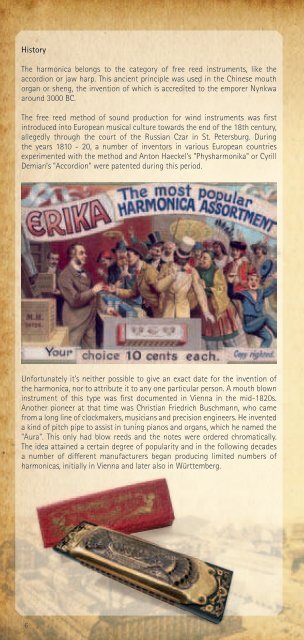Hohner Harmonicas Pocket Guide 2009 - Sutherland Trading
Hohner Harmonicas Pocket Guide 2009 - Sutherland Trading
Hohner Harmonicas Pocket Guide 2009 - Sutherland Trading
You also want an ePaper? Increase the reach of your titles
YUMPU automatically turns print PDFs into web optimized ePapers that Google loves.
History<br />
The harmonica belongs to the category of free reed instruments, like the<br />
accordion or jaw harp . This ancient principle was used in the Chinese mouth<br />
organ or sheng, the invention of which is accredited to the emporer Nynkwa<br />
around 3000 BC .<br />
The free reed method of sound production for wind instruments was first<br />
introduced into European musical culture towards the end of the 18th century,<br />
allegedly through the court of the Russian Czar in St . Petersburg . During<br />
the years 1810 - 20, a number of inventors in various European countries<br />
experimented with the method and Anton Haeckel's "Physharmonika" or Cyrill<br />
Demian's "Accordion" were patented during this period .<br />
Unfortunately it's neither possible to give an exact date for the invention of<br />
the harmonica, nor to attribute it to any one particular person . A mouth blown<br />
instrument of this type was first documented in Vienna in the mid-1820s .<br />
Another pioneer at that time was Christian Friedrich Buschmann, who came<br />
from a long line of clockmakers, musicians and precision engineers . He invented<br />
a kind of pitch pipe to assist in tuning pianos and organs, which he named the<br />
"Aura" . This only had blow reeds and the notes were ordered chromatically .<br />
The idea attained a certain degree of popularity and in the following decades<br />
a number of different manufacturers began producing limited numbers of<br />
harmonicas, initially in Vienna and later also in Württemberg .<br />
In 1827, instruments built in Vienna arrived in the Black Forest town of<br />
Trossingen . Here, Christian Messner was the first to delve into the secrets of<br />
manufacturing and improving them .<br />
Some years later Josef Richter, an instrument maker from Bohemia, was<br />
responsible for the introduction of draw reeds and also invented a new 10-hole<br />
tonal layout which bears his name to this day: the Richter tuning . Mr Richter<br />
used only the notes of a single major scale and ordered them so that they<br />
produced a tonic chord when blown and a dominant 7th chord when drawn .<br />
This turned the simple "Aura" into an ideal instrument for the two chord folk<br />
melodies which were popular at the time .<br />
In 1857 an enterprising young man from Trossingen named Matthias <strong>Hohner</strong><br />
recognized the commercial potential of the instruments his fellow townsmen<br />
were building and decided to do it better by starting his own harmonica<br />
factory . His early instruments were tuned according to the Richter system and<br />
were bascially similar to today's blues harps .<br />
In 1865 <strong>Hohner</strong> began exporting to the USA . Diatonic Richter harmonicas<br />
rapidly became enormously popular and <strong>Hohner</strong> was soon forced to introduce<br />
modern industrial production methods to keep up with demand . Within a<br />
relatively short time, the high quality of his products, their attractive appearance<br />
and clever packaging had made <strong>Hohner</strong> the market leader, while their low price<br />
made his instruments affordable for everyone .<br />
In 1896 <strong>Hohner</strong> registered the US patent for what was to become the most<br />
successful harmonica model of all time - the <strong>Hohner</strong> Marine Band . Other<br />
diatonic models including tremolo and octave tunings were also introduced .<br />
6 7




